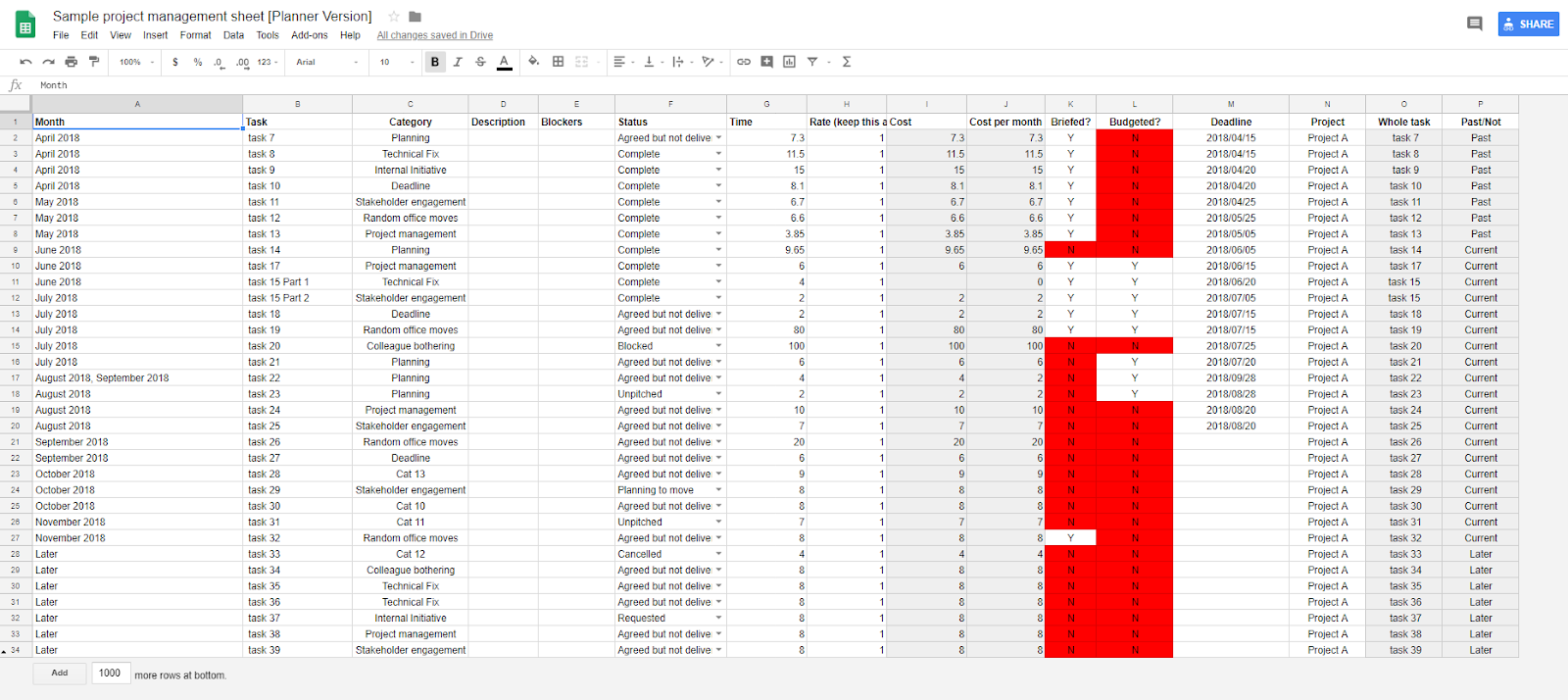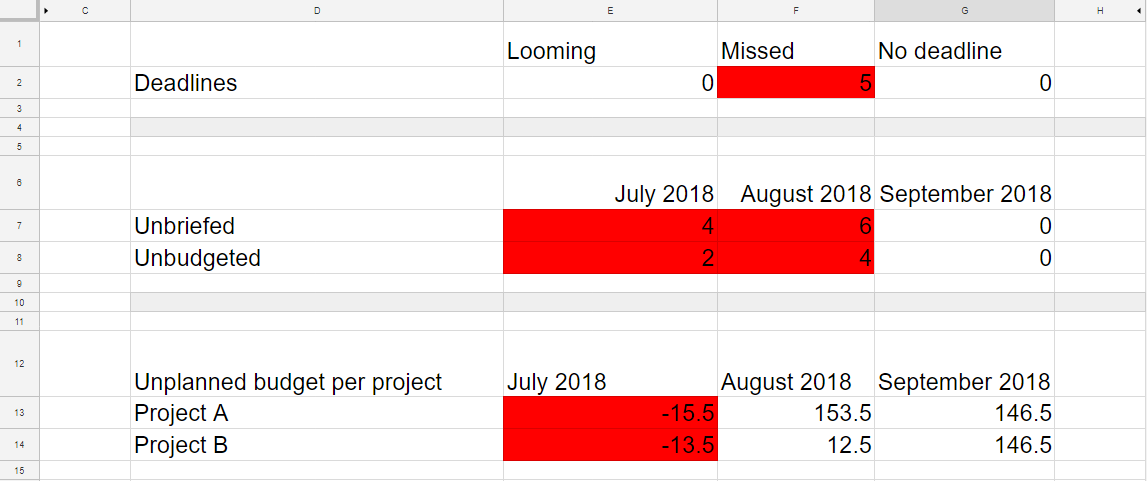If you’d like to skip this post and get straight to the templates, you can access them here (but I’d recommend reading a bit about how they work first): Planner Version (everything you need to know, plus Gantts) Stakeholder Version (a cleaner version for bosses, clients, or people doing the work but not project managing) What-in-God's-name-have-I-missed Version (combined view of lots of different projects, showing you if you’ve forgotten to tell someone about work, missed a deadline, or over-planned) It’s worth mentioning: I don’t consider these sheets to be the only solution. Contents (for if you just want to jump to a specific section): The 3 principles (which are about people as much as using the sheets) An early conclusion Appendices & instructions How to add tasks to the list Splitting tasks across multiple time periods Working with the Month View tab (Planner and Stakeholder Versions) How to make the Gantt charts work (and add categories) How to make the Category-Filterable Forward-Facing Gantt Charts work How to create the Stakeholder View How to update the God's-I Version The principles (which are about people as much as using the sheets) Principle 1: We shouldn’t need to store all our information in our heads. We can try to be as informed as possible, but they’re still likely to know something we don’t. We never have to fill out the Stakeholder Version sheet — it just grabs that information from the Planned tab using importrange() and creates all the same Gantt charts and monthly views — so we don’t have to worry about different plans showing different information. Access the template sheets here: Stakeholder Version (a cleaner version for bosses, clients, or people doing the work but not project managing) What-in-God's-name-have-I-missed Version (combined view of lots of different projects, showing you if you’ve forgotten to tell someone about work, missed a deadline, or over-planned) Appendices & instructions Some general notes Quick notes on avoiding problems: Make sure that when you copy the sheets, the sharing permissions for the Planner View is email- or at least organization-based (anyone with access to the Stakeholder View will see the Planner View URL). That means that other cells are calculating or looking up against cells which may or may not be empty, so I’ve added the isblank() check so that the cells don’t break when there isn’t information somewhere, but as you add information you don’t have to do as much copying and pasting of formulas. Column C in the Task View tab is the category; you also need to fill this out for the Gantt charts to work. Where the intersection of a month and task matches a task in our Task View (as in the task in that row is taking place during the month in that column), the filter formula will return the category. The reason we check whether the task or month cells are empty, as mentioned above is so we can paste the above formula in all the cells of the Gantt chart and have them fill out as we add more months and tasks, rather than having to copy and paste the formula each time. To make sure the Stakeholder Version keeps functioning when you create copies of both of these files, all you need to do is go to the new Planner Version sheet and copy the URL of the page, then go to the Stakeholder Version, find the Task View tab, and update the importrange() formula in cell A1 to have the new URL of your Planner Version sheet.

The short version of this post: Project management is a vital part of our job as marketers, but planning and visualizing projects over time is hard, so I’ve created a set of Google Sheets to make that work easier for you.
I’ve found this system helpful in a number of ways, so I’m sharing my templates here in case it’ll make your day a bit shorter. I’ll start off with a brief overview of what the sheets do, but in the latter section of this post I’ll also go into greater depth about how they work so you can change them to suit your own needs.
If you’d like to skip this post and get straight to the templates, you can access them here (but I’d recommend reading a bit about how they work first):
- Planner Version (everything you need to know, plus Gantts)
- Stakeholder Version (a cleaner version for bosses, clients, or people doing the work but not project managing)
- What-in-God’s-name-have-I-missed Version (combined view of lots of different projects, showing you if you’ve forgotten to tell someone about work, missed a deadline, or over-planned)

It’s worth mentioning: I don’t consider these sheets to be the only solution. They are a free solution that I’ve found pretty useful, but I have colleagues who swear by the likes of Smartsheet and Teamwork.
It’s also worth noting that different tools work better or worse with different styles. My aim with these sheets is to have a fairly concrete plan for the next three or four months, then a looser set of ideas for further down the line. When I’m filling out these sheets, I also focus on outcomes rather than processes – that helps cut down the time I spend updating sheets, and makes everything clearer for people to read.
The long version of this post is a lot like the short version above, but I talk more about some principles I try to stick to and how this setup fulfills them (shocker, eh?). As promised, the final section will describe how the sheets work, for anyone who runs into problems or wants to make something of their own.
Contents (for if you just want to jump to a specific section):
The 3 principles (which are about people as much as using the sheets)
An early conclusion
Appendices & instructions
How to add tasks to the list
Splitting tasks across multiple time periods
Working with the Month View tab (Planner and Stakeholder Versions)
How to make the Gantt charts work (and add categories)
How to make the Category-Filterable Forward-Facing Gantt Charts work
How to create the Stakeholder View
How to update the God’s-I Version
The principles (which are about people as much as using the sheets)
Principle 1: We shouldn’t need to store all our information in our heads.
This is a simple one — if we have to regularly understand something complex, particularly if it changes over time, that information has to be on the page. For example, if I’m trying to plan a marketing strategy and I have to constantly look at the information on the screen and then shuffle it around in my head to work out what we have time for month to month, I’m going to lose the thread and, eventually, my mind.
The Planner Version sheet aims to solve this in a few ways. First, you write all the tasks down in the Task View tab, the time period you’re completing them in is on the far left (in my example, it’s the month the task is planned for), and there are other columns like status and category — but initially, it can just be a brain dump of what needs to happen. The idea here is that when you’re first writing everything out, you don’t have to think too much about it — you can easily change the dates and add other information later.

The Month View tab takes the information in the Task List tab and reorders it by the months listed in column A of the Task View (it could be other time periods, as long as it’s consistent).
This way you can look at a time period, see how much resource is left, and read everything you currently have planned (the remaining resource calculation will also take into account recurring tasks you don’t always want to write out, like meetings).

While the Month View tab can help you focus on specific time periods, it doesn’t give you a long-term view of the plan or task dependencies, so we have the two Gantt views. The Gantt View tab contains everything from sixty days ago and into the future, as long as you haven’t just marked the task as “Later.” The Category-Filterable Gantt only focuses on things that are planned for the next six months.
As the name suggests, you can filter this second Gantt to only show specific categories (you label tasks with categories in the Task View tab). This filter is to help with broader trends that are harder to notice — for instance, if the most important part of the project is a social campaign or a site change and you don’t get to it for six months, you may need to make sure everyone is aware of that and agrees. Likewise, if you need to be showing impact but spend most of your time reporting, you may want to change your plan or make sure everyone understands why things are planned that way.

Principle 2: No one knows everything (and they shouldn’t).
If you’re working on a project where you have all the information, then one of two things is likely happening:
- You’ve really doubled down on that neuroticism we share
- You’re carrying this thing — you should just quit and start your own company selling beads* or something.
We can trust that our clients/bosses have more context than we do about wider plans and pressures. They may know more about wider strategies, that their boss tenses up every time a certain project is mentioned, or that a colleague hasn’t yet announced their resignation. While a Google Sheet is never an acceptable substitute for actual communication, our clients or bosses may also have an idea of where they want the project to go which they haven’t communicated, or which we haven’t understood.
We can also trust that people working on individual tasks have a good idea of whether things are going to be a problem — for instance, if we’re allowing far too little time for a task. We can try to be as informed as possible, but they’re still likely to know something we don’t.
Even if we disagree that certain things should be priorities or issues, having a transparent, shared plan helps us kick off difficult conversations with a shared understanding of what the plan currently is. The less everyone has to reprocess information to understand it (see Principle 1), the more likely we are to weed out problems early.
This is all well and good, but expecting someone to absorb everything about a project is likely to have the opposite effect. We need a source of data that everyone can refer to, without crowding their thoughts or our conversations with things that only we as project managers have to worry about.
That’s why we have the Stakeholder Version of our sheets. When we write everything in the Planner Version, the Planned tab is populated with just the things that are relevant for people who aren’t us (i.e, all the tasks where the status isn’t “unpitched,” “cancelled,” “forgotten,” or blank) with none of the resource or project identifier information.
We never have to fill out the Stakeholder Version sheet — it just grabs that information from the Planned tab using importrange() and creates all the same Gantt charts and monthly views — so we don’t have to worry about different plans showing different information.


*Bees?
Principle 3: I’m going to miss stuff (less is more).
I’ll be honest: I’ve spent a bunch of time in the past putting together tracking systems that I don’t check enough. I keep filling them out but I don’t spend enough time figuring out what’s needed where. If we have a Stakeholder Version which takes out the stuff that is irrelevant to other people, we need the same for us. After all, this isn’t the only thing we’re thinking about, either.
The What-in-God’s-name-have-I-missed Version (God’s-I from now on) pulls in data from all of your individual project management sheets and gives you one place to go to be reminded about all the things you’ve forgotten and messed up. It’s like dinner with your parents in a Google Sheet. You’re welcome.
The three places to check in this version are:
- Alerts Dashboard tab, which shows you the numbers of deadlines upcoming or missed, the work you need to budget for or brief, and how much unplanned budget you have per project, per month (where budget could just be internal people-hours, as that is still finite).
- Task Issues tab, which gives a filterable view of everything over the next three months (so you can dig in to the alerts you see in step one).
- Deadlines This Week tab so you have a quick reminder of what you need to complete soon.

An early conclusion:
Often, when I’m making a point, people tell me they hope I’ll wrap up early. This section is mainly proof of personal growth.
It’s also because everything after this is specific to using, changing, or understanding the project management sheets I’ve shared, so you need only read what follows if you’re interested in how to use the sheets or how I made them (I really do recommend dabbling with some uses of filter() and query(), particularly in conjunction with RegEx formulas).
Aside from that, I hope you find these resources useful. I’ve been getting a lot of value from them as a way to plan with people collaboratively and separate the concept of “project manager” from “person who needs to know all the things,” but I would be really interested in any thoughts you have about how to improve them or anything you think I’ve missed. Feel free to comment below!
Access the template sheets here:
- Stakeholder Version (a cleaner version for bosses, clients, or people doing the work but not project managing)
- What-in-God’s-name-have-I-missed Version (combined view of lots of different projects, showing you if you’ve forgotten to tell someone about work, missed a deadline, or over-planned)
Appendices & instructions
Some general notes
Quick notes on avoiding problems:
- Make sure that when you copy the sheets, the sharing permissions for the Planner…

COMMENTS